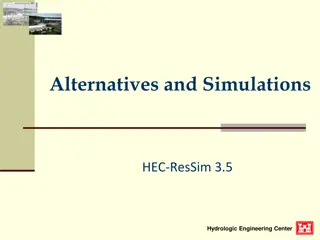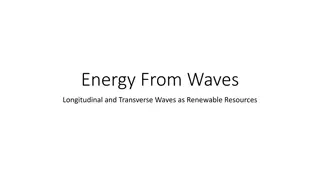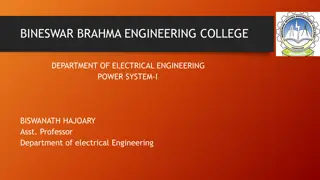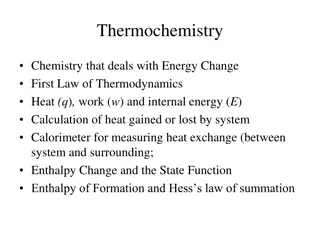Next Generation Energy Alternatives: A Comprehensive Overview
Exploring various next-generation energy alternatives, this article delves into renewables like carbon capture and storage, nuclear options including small-scale plants, and innovative fusion technologies. It discusses the potential, challenges, and advancements in these cutting-edge energy sources.
Download Presentation

Please find below an Image/Link to download the presentation.
The content on the website is provided AS IS for your information and personal use only. It may not be sold, licensed, or shared on other websites without obtaining consent from the author. Download presentation by click this link. If you encounter any issues during the download, it is possible that the publisher has removed the file from their server.
E N D
Presentation Transcript
Next Generation Alternatives: The Future or Flavor of the Month? Part B Peter Schwarz Professor of Economics, Belk College of Business and Associate, Energy Production and Infrastructure Center (EPIC) UNC Charlotte of 12 1
Outline Introduction What is a Next-Generation Energy Alternative? Next-Generation Renewable Energy Next-Generation Non-Renewables Other Next-Generation Alternatives The Role of Markets and Governments in Next-Generation Technologies of 12 2
Next Next- -Generation Non Generation Non- -Renewables (1) Carbon Capture and Storage (CCS) Renewables (1) Option for electricity generation and industrial processes using coal or natural gas Coal is most important as it emits 2x as much carbon as NG Attempts to date have proved very expensive Three-step process Separate CO2 from other gas by-products. Transport as we would natural gas. Bury underground, or find a re-use. Coca-CO2la Soil remediation Enhanced oil and gas recovery Methanol and other fuels of 12 3
Next Next- -Generation Non Generation Non- -Renewables (2) Nuclear Nuclear Renewables (2) Small scale plants Primary advantage is lower financing cost Easier shipping of components Another use is for remote locations off the grid Disadvantages Higher levelized cost While less waste per reactor, multiple reactors More costly to protect many plants against terrorism PWR Passive safety Nuclear fusion of 12 4
Next Next- -Generation Non Generation Non- -Renewables (3) Nuclear Nuclear Renewables (3) Alternative designs and fuels Gen III+ U.S. plants under construction Passive safety Way over budget Gen IV by 2030 Thorium Cheaper, safer However, fission reaction doesn t produce as much energy. MOX and Plutonium MOX 95% uranium, 5% Plutonium Plutonium from recycled fuel Research halted at Savannah River plant of 12 5
Next Next- -Generation Non Generation Non- -Renewables (3) Nuclear Nuclear Renewables (3) Fusion Needs to produce more energy than it consumes. Requires hotter temperature than sun in a contained reaction Uses huge amount of energy to maintain magnetic field ITER (International Thermal Experimental Reactor) Commercialization by 2050 Tokomak : Torus- shaped like donut In the end, another (very expensive) way to boil water CERN (Conseil Europe n por la Recherche Nucl aire) Large Hadron Collider Particle accelerator Recall Superconducting Supercollider of 12 6
Other Next Other Next- -Generation Alternatives (1) Generation Alternatives (1) Hydroelectric (1) Hydroelectric (1) Hydroelectric Challenge to find new sites Small-scale hydro Will avoid use of dams and ecological consequences. 30 MW vs. 500 MW Can connect to grid Or isolated areas off the grid. To be economical Near customers Sufficient stream flow or other source of water Other sources if hydro unavailable Seasonal variations such as drought. of 12 7
Other Next Other Next- -Generation Alternatives (2) Generation Alternatives (2) Hydroelectric (2) Hydroelectric (2) Wave and tidal power Depends upon size of waves and change in tides Expensive to build and maintain More predictable than wind or solar Less predictable than fossil fuels or nuclear Wave energy technology Employs buoys or floats Buoys are moored in water Harnesses power from rise or fall of waves to drive hydraulic pumps. Water moves pump. Tidal energy Uses dam-like structure Impact on ecology, less than traditional permanent dam. Needs to be close to shore Impacts view, alternative uses such as recreation. U.S. DOE funding projects to extend life of facilities. of 12 8
Other Next Other Next- -Generation Alternatives (3): Generation Alternatives (3): Fuel Cells and Batteries (1) Fuel Cells and Batteries (1) Fuel Cells Electricity as well as transportation (discussed earlier) High cost Requires external source of hydrogen (discussed earlier) and oxygen Chemical reaction, no combustion So no emissions (except water vapor) Requires electricity to produce chemical reaction Where there are emissions, unless renewable energy used. Hydrogen storage Suppliers can balance value for electricity, transportation, industry uses. Hydrail of 12 9
Other Next Other Next- -Generation Alternatives (3): Generation Alternatives (3): Fuel Cells and Batteries (2) Fuel Cells and Batteries (2) Fuel Cells and Batteries Batteries Expensive Stores energy internally Stores electricity Unlike fuel cell, does not generate electricity Re-use or dispose (environmental issue) Grid scale or distributed generation Even electric vehicles can supply power to electricity grid Lithium ion battery most common Environmental and national security concerns Needs incentive: Higher payment for providing ancillary services backup electricity, stabilizing voltage, etc. U.S. DOE funding projects with different technologies of 12 10
The Role of Markets and Government in Next The Role of Markets and Government in Next- - Generation Technology (1) Generation Technology (1) Research and Development (R & D) Public goods characteristics Non-rival If non-excludable, free riders Market will underprovide Patents provide incentive, but exclude inefficiently And monopoly rights Public-private partnerships Florida Power & Light Turbines powered by solar or natural gas when solar unavailable. CERES partners with SUNY New PV materials. Using computer-chip technology In conjunction with U.S. DOE funding of 12 11
The Role of Markets and Government in Next The Role of Markets and Government in Next- - Generation Technology (2) Generation Technology (2) Government failure can also occur Nuclear Regulatory Commission May lobby for nuclear research Modular plants Fusion research Against CCS, renewables research Corn-based As we have said before, first-best policy is carbon market In its absence, choose between two imperfect alternatives Market failure Government failure of 12 12























